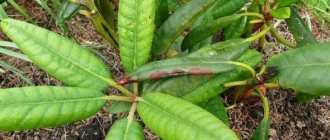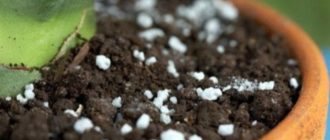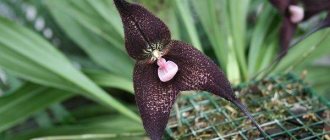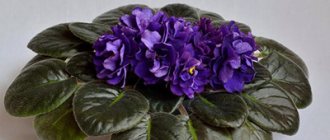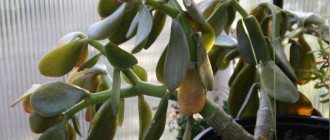Author: Elena N. https://floristics.info/ru/index.php?option=com_contact&view=contact&id=19 Category: Plant Diseases Published: November 13, 2017Last edits: July 21, 2020
- Black spot of tomatoes
- Black spot on grapes
- Black spot on roses
Symptoms of black spot on different plants are caused by different pathogens. For example, black spots on the leaves of roses are caused by the fungus Marssonina rosae, and black spots on lilacs are caused by bacteria of the genus Syringae. In our article, we will try to describe in detail what causes and how diseases with such symptoms occur on different plants, and will also tell you how to protect your garden from this disease.
Black spot disease - description
Black spotting appears as dark brown, almost black spots with a light center or, conversely, light edges. Round or oblong swellings may form on the spots. Signs of the disease usually appear in early summer. With its rapid development, the disease covers large areas of leaf tissue, as a result, the leaves turn prematurely yellow and fall off, the branches become bare, the plants weaken and develop poorly, bloom and bear fruit. The infection is spread by wind, water and insects. Black spot progresses during periods of prolonged rains against the background of low temperatures and a deficiency of potassium in the soil. The cause of the disease can be mechanical damage to the bark or leaves of the plant.
Thrips on indoor plants. Flower thrips
Many lovers of ornamental plants may notice small black dots on the underside of the leaf. And only a few know that these are thrips on indoor plants - small pests that become especially aggressive in spring and summer, causing great harm to the crop. Pests suck sap from flowers and leaves and also transmit viral diseases. As a result of their influence, flowers fall off, leaves dry out, and secretions of their vital activity appear, on which sooty fungus can settle.
Black spot treatment
Measures to combat black spotting
First of all, you need to be sure that you are dealing with black spot, and there are two options: if you find symptoms of this disease on a rose, then you will have to fight a fungus, and if on a tomato or pepper, then it is bacterial black spot. spotting. However, there are methods of control that are common to diseases of any nature and are aimed primarily at improving plant health. That is, there are a number of measures that simply do not allow the infection to develop on the plant.
Black spotting - prevention
First of all, you need to take a responsible approach to choosing the place where you are going to grow this or that crop. This means that light-loving plants do not need to be planted in the shade and, conversely, shade-loving crops cannot be grown in full sun: this weakens the plants and makes them susceptible to infections. The quality of the soil is also of great importance: you must adapt the soil on the site as much as possible to the requirements of the crop being grown. When choosing plant varieties, give preference to those that are resistant to diseases and pests. It is also important that these varieties are adapted to the conditions of your region. Disinfect seed material, especially if it came to you from a little-known source. Plant plants within the time limits recommended by professionals according to developed schemes, comply with the necessary agrotechnical conditions, regularly carry out preventive treatments of plants against diseases and pests, maintain a balance in fertilizing and soil moisture. After harvesting, do not forget to remove plant debris from the site and tidy up the soil.
- Currants: diseases and pests, how to treat them
Treating thrips on plants at home
Unlike humans, our indoor plants cannot complain about feeling unwell or talk about their ailments. Therefore, when caring for flowers, you need to very carefully monitor any noticeable external changes in your pets. Thrips on houseplants are one of the most dangerous parasites. Having settled on your dracaena or monstera, they can not only disfigure the flower, but also lead to its death. However, it is not always possible to recognize the pest in the early stages, since it hides very skillfully. And yet, it also leaves traces that can be used to identify the parasite and get rid of it.
Black spotting of plants (garden)
Black spot of tomatoes
The causative agent of bacterial black spot, which affects tomatoes both outdoors and indoors, is the gram-negative rod-shaped bacterium Xanthomonas vesicatoria. Watery pinpoint spots form on the leaves of seedlings and young plants, increasing in size to 1-2 mm, and the edges of these spots gradually turn yellow. On adult plants, the spots are located mainly along the edges of the leaves, as well as on the petioles and stems. Bacterial spotting also appears on tomato fruits in the form of dark convex dots with a watery border, increasing to 6-8 mm and turning into sores. The causative agent of the disease can survive on seed and plant debris, which is why it is so important to treat tomato seeds before sowing for seedlings.
The bacterium can penetrate into the ground organs of the plant through cracks, breaks, or any mechanical damage. It quickly spreads through tissues: from the moment of infection until the first signs appear, 3-5 days pass; on fruits, symptoms of spotting appear later, and the infection spreads to neighboring plants within two weeks. Air temperatures above 25 ºC contribute to the development of the disease, and at lower temperatures the disease only slows down its development, but does not go away. Another condition for the rapid development of bacterial spotting is increased air humidity to 70-75% and direct contact of moisture with the ground organs of the plant. Under such conditions, black bacterial spot develops rapidly on tomatoes.
Tomato diseases and their treatment
The bacterial pathogen persists as long as there is a food source, but on cleanly harvested soil after harvest it dies within 4-5 weeks.
It must be said that scientists have not yet developed tomato varieties that are resistant to bacteriological spot, but tomatoes that are not susceptible to fungal diseases also offer decent resistance to black spot. In the fight against the bacterium, preventive measures are of paramount importance, for example, treating seeds before sowing. This can be done in the following ways:
- keep the seeds for one hour in the fungicide solution;
- treat the seeds for half an hour in a pink solution of potassium permanganate;
- dissolve 12 g of Trisodium Phosphate in 100 g of water and dip the seeds into the solution for 1 hour, then rinse them very thoroughly in a sieve or under running water for 20-30 minutes;
- hold the seed for 20 minutes in water at a temperature of 60 ºC.
Using these simple methods, you can destroy the infection located on the surface of the seeds, but you need to fight the internal seed infection differently: before sowing, soak the seeds for 6 hours in a one percent solution of the biofungicide Planriz.
Before planting in the ground, tomato seedlings are also treated twice with Planriz, Fitosporin-M, Gamair or Baktofit. Fitolavin is very effective on tomatoes, which destroys not only the causative agents of bacterial spot, but also bacterial cancer, blossom end rot and other diseases of nightshade crops.
- Root rot
Subsequently, growing tomato bushes are treated from time to time for preventive purposes with copper-containing preparations: a one-percent solution of Bordeaux mixture, Oksikhom, Khom and other fungicides of similar action.
Black spot of pepper
Sweet peppers are parasitized by the same bacterium as tomatoes: Xanthomonas vesicatoria. Most often, it affects young organs, forming watery pinpoint spots on stems, leaves, cotyledons, fruits and petioles, which turn black over time and acquire an angular or rounded shape. These black spots, surrounded by a yellowish border, reach 1-2 mm in size. The spots spread along the veins of the leaves, and light yellow necrosis with dark edges forms in their center. Black convex dots, surrounded by a watery border, also first appear on the fruits. They gradually increase to 6-8 mm and turn into rotting sores.
Both preventive and therapeutic measures to combat the causative agent of bacterial black spot on peppers are absolutely the same as on tomatoes.
How to normalize care?
The conditions for keeping the flower are as close to natural as possible, alternating abundant watering with warm water and drying out the substrate. Good soil drying is ensured by:
- free air circulation ;
- regular ventilation .
In the room where the orchids are located, drafts must be excluded .
When determining the frequency and abundance of watering, take into account:
- pot volume;
- room temperature;
- substrate density.
Attention! The watering regime for orchids is set based on the condition of the soil in the pot, and not on the period of time after which watering is carried out.
An orchid that has black spots due to improper care is rearranged:
- to diffuse sunlight . In the autumn-winter period, additional lighting may be needed;
- summer daytime air temperature in the apartment should be from 15 to 30℃ , in winter – 20-23℃ . Daily fluctuations in day and night temperatures are within 3-5 ℃;
- The ambient humidity is at least 50 , and for some types of orchids (Vanda) - more than 60%.
In favorable conditions, the flower will be able to recover as quickly as possible.
Treatment of black spot on fruit and berry crops
Black spot on grapes
Grape black spot, or escoriosis, or phomopsis, or shoot dieback, or bark cracking, or dry sleeve, is caused by the fungus Phomopsis viticola. It appears in June on the nodes of annual shoots as black-brown or black dots of round or oval shape - swellings of tissue with a focus of necrotic cells in the center. As escoriosis develops, the number of dots increases and they begin to merge into spots that open in the middle. The darker edges become covered with cork tissue and look like scabs. Spotting usually affects the first 6-7 internodes of the shoot. The lowest leaves, tendrils, cluster ridges and even flowers are infected. Leaf necrosis is surrounded by a light, dense border; tissue tension causes the leaf plate to become curled, rupture, and holes appear. Leaves turn yellow prematurely. Due to deformation and tearing of leaves, photosynthesis is weakened, and more than half of the buds in the lower internodes of annual shoots may die. Blackspot-affected berries turn dark purple and have an unpleasant taste, and annual wood turns whitish-gray.
The pathogen spreads with dew, rain, wind, insects and penetrates the plant through mechanical damage and stomata. Black spot reduces the winter hardiness of grapes, and if it is not dealt with, the disease will destroy the plant in 5-6 years.
When growing grapes, you should give preference to varieties that are resistant to black spot. The most famous among them are Cabernet Sauvignon, Lyana, Traminer, Tavrida, Iskra, Riesling, Bastardo Magarachsky, Relay. If the disease has already affected your grapes, begin treatment immediately, however, due to the fact that the mycelium of the fungus is deep in the tissues, attempts to destroy black spot with fungicides will be ineffective, but treating grapes with chemicals DNOC or Nitrafen can affect fruiting bodies and spores. And if you regularly carry out preventive treatments against fungal diseases, then black spotting will bypass your grapes.
During the growing season, as a preventive measure, grapes are sprayed with one percent Bordeaux mixture or the preparations Euparen, Efal, Mikal, and these treatments must be started even earlier than prevention against anthracnose and mildew: the grapes are sprayed for the first time when the buds swell on them, and after 4-5 leaves will appear on the shoots, carry out the second treatment. The third time the grapes are sprayed after they have flowered, and it is advisable to use a product that is effective not only against black spot, but also destroys the pathogens of powdery mildew and peronospora.
- Brown spot: treatment and prevention, control measures
In late autumn, if the grapes are severely affected by black spot, after pruning or defoliation, they are sprayed with a copper-containing preparation so abundantly that the bushes are literally washed with a medicinal solution. Sleeves showing signs of drying should be removed. Fungicides Maxim, Captan, Mancozeb and Triadimenol have proven themselves to be effective against black spotting on grapes. To avoid infection, the following preventive measures should be taken:
- plant only healthy vines;
- regularly inspect the vineyard, monitor the health of the plants;
- immediately after detecting signs of the disease, remove and burn the affected areas of the plant;
- tie up shoots, not allowing them to lie on the ground;
- feed the grapes with a balanced fertilizer, which should include microelements such as zinc and boron.
Since black fungal spot is a chronic disease, be prepared for a long battle. But even if you destroy all infectious agents in your vineyard, preventive work must be continued.
Main pests of indoor plants
The most common pest of indoor flowers.
Characteristic signs of damage: if the leaf is exposed to light, pinpoint punctures, whitish or yellowish, are visible. Gradually they merge into spots. The leaves turn pale and acquire a grayish tint. Then the leaves dry out and completely lose color. This is a typical pattern, but in some cases the leaves turn red or bronze. In some plants, the leaves do not change shape even when the spots are large, in other cases they are severely deformed and curled. Here are photographs of spider mites for quick identification of the pest on indoor plants. How to distinguish who is eating your flowers and how to deal with the pest.
The leaves turn yellow, cobwebs have appeared on the flowers, dots appear on the leaves as if pricked by a needle, the flowers do not grow, the tops of the shoots wither - these are signs of spider mites. Advice from experienced gardeners on how to fight ticks using folk remedies or chemicals.
A package of orchids arrived, and there were black bugs, like ticks, running around quickly. Who is this?
Oribatid mites or oribatids are soil arthropods. By 2015, more than 7,000 species of oribatid mites have been described. Who are they - pests or beneficial living creatures? Do we need to destroy them, what means should we use to fight them? What to do if orchid mites have settled in orchid pots.
What do armored mites look like, how to distinguish them from herbivorous mites: spider mites, flat mites and broad mites.
Thrips on indoor flowers are not uncommon; they enter our home from the street, garden flowers, purchased indoor plants, and cut flowers (from bouquets). They spread very quickly on house plants, sucking juices from them, contaminating the leaves with skins and excrement. Thrips is dangerous because it has several stages of development, some of which are secretive - females lay eggs directly in the leaf tissue, and nymphs hide in the ground. In addition, eggs and nymphs have integuments that protect them from the action of contact insecticides. Therefore, the fight against thrips takes place in several stages.
Silver spots, discolored areas appear on the leaves, shoots dry out and become deformed, the plant does not bloom, the leaves turn yellow, small black drops or crumbs appear on the surface of the leaves - these are signs of thrips. Look at photos of the pest and compare it with your plant.
You might find some tips on how to deal with thrips useful.
From the point of view of indoor floriculture, the danger of scale insects is that due to parthenogenesis - the birth of females without fertilization, scale insects can reproduce all year round, producing about 5-6 generations, the process of changing generations is continuous. At the same time, males among indoor scale insects are extremely rare, but if they appear, for some reason they are very scary. Someone begins to think that this unknown, terribly gluttonous creature. In fact, the development cycle of scale insects, with or without males, is no different. The males themselves do not harm the plants - they simply have nothing to eat. In fact, male scale insects hatch for a single mission - fertilization, therefore, all they have are eyes, wings and genitals.
What do scale insects and false scale insects look like - brown spots on stems, petioles, leaves, translucent or with a dense brown shield, flat or convex. The smallest ones are almost invisible, but if you peel it off and press it with a needle, a wet mark remains. And how the leaves of various plants affected by scale insects look, look at the photographs of various plants.
Advice from experienced gardeners on how to cure scale insects using folk remedies and medications.
The bristlebug or mealybug is a small insect that lives on plants. Its body is covered with a white, waxy coating, which makes clusters of pests look like cotton balls.
Scale insects cause serious damage to indoor plants, and it is quite difficult to remove them at home. What to look for: If the leaves turn yellow and fall off, the shoots are stunted, small white spots are visible on the stems or under the leaves. Scale insects climb under the bark of indoor fruit exotics, under the scales of bulbs of hippeastrums and other bulbous plants, and hide in the fluffy hairs on the stems of begonias. Sooty fungi can settle on the secretions of scale insects.
You won’t always notice this pest right away: scale insects can hide for a long time in the root zone, near the surface of the ground, or in the axils of leaves.
And only when the colony of scale insects grows numerous and voracious will the pests be noticeable on the leaves. But by this time, as a rule, the plant withers, turns yellow irrevocably and dies.
Whitefly is a pest of indoor and garden plants; all species easily reproduce in an apartment; some species quietly winter in mid-latitudes and breed under our windows in the spring. The whitefly especially loves celandine, which grows under our windows, and in gardens it spoils any vegetables, especially cabbage, and berries.
How to identify the pest - photo of whitefly, measures to combat whitefly.
At home, aphids can cause harm all year round. They multiply quite quickly, forming colonies that cover more and more territory. But unlike mites, aphids are large pests and are easy to see with the naked eye. Aphids focus on the most tender parts of the plant - the tops of shoots, buds, flowers. For many plants, the easiest way is to prune the affected shoots and tear off the flower stalks. For plants that form a rosette, wash the leaves with a sponge and green soap, and clean the leaf axils with a cotton swab dipped in alcohol.
If aphids are very rampant on indoor flowers, spray the plants with any insecticide. The following drugs will help you: Aktara, Confidor, Tanrek, Fitoverm, Inta-Vir, Iskra, Iskra-Bao, Deciss and other drugs.
Black spot on flowers
Black spot on roses
Black spot of roses is caused by the fungus Marssonina rosae, which attacks the leaves and green shoots of the plant. On the upper side of the rose leaves, red-white and then black rounded radiant spots appear, as if bordered by a fringe. The lesion begins with the lower leaves, but the disease quickly covers the entire bush. Diseased leaves become gray-brown, curl, die and fall off, the rose weakens, forms fewer buds or refuses to bloom at all. If the damage is severe, some bushes may even be left without leaves by autumn.
As soon as you see signs of disease, remove diseased leaves from and under the bush. How to deal with black spot on roses? Every 7-12 days, treat the bushes with a solution of a fungicide - Abiga-Pika, Bordeaux mixture, Previcur, Skor, Topaz, Fundazol, Mancozeb, Thiophanate-methyl or Trifloxystrobin, and spill the soil around the bush 2-3 times with a solution of Fitosporin-M. In the fall, before covering the rose for the winter, collect all the leaves from the bush and from under it and burn them, and treat the bare bush with a three percent solution of iron sulfate. In the spring, before the start of the growing season, trim the shoots and branches of the rose to healthy wood, then treat the bush and the soil under it with one of the listed preparations.
Planting and caring for roses in the garden
Black spot (marsonina) can be confused with diseases such as brown spot, peronospora, phyllosticosis, cercospora, septoria, purple spot, ascochyta and sphacelloma. However, if there is confusion in diagnosis, do not be discouraged: all these diseases are treated with fungicides.
What causes them to appear in house flowers?
The causes of diseases in domestic flowers may be as follows:
- using contaminated soil when replanting - for example, taken from a garden or vegetable garden,
- weak plant immunity,
- transfer of pathogens through contact with an infected flower,
- use for planting flowers infected with pathogens.
Important! If you come into contact with a diseased plant, you must thoroughly wash your hands and disinfect equipment before contacting healthy flowers.
Improper care
The possibility of infection of indoor flowers increases significantly if they are not properly cared for:
- High humidity and lack of normal air circulation in the room are favorable conditions for the development of pathogens.
- Poor soil aeration or incorrectly selected soil for certain types of flowers.
- Constant hypothermia due to drafts.
- Insufficient nutrient content in the soil due to the lack of scheduled fertilizing.
Each flower needs appropriate care. If you deviate from the norm, the likelihood of contracting diseases increases.
If the cause is pests
Pests and insects parasitizing flowers can appear in the following cases:
- transferring indoor flowers to the open air in the warm season,
- infection through the air with open windows or doors,
- infection from an infected plant,
- use of undisinfected soil from the garden or vegetable garden.
By following basic precautions, the likelihood of flowers being damaged by parasites can be significantly reduced.
Preparations for black spot (fungicides)
When choosing drugs against a particular disease, you should have at least an approximate idea of their action and purpose. We offer you a list of fungicides that will help you fight not only black spot, but also other fungal diseases.
- Abiga-Pik is a copper-containing broad-spectrum contact fungicide designed to combat fungal and bacterial diseases;
- Baktofit is a biological preparation for combating bacterial and fungal diseases;
- Bordeaux mixture is a broad-spectrum contact fungicide for protecting vegetables, fruits, berries, melons and other crops from fungal diseases;
- Gamair is a biological bactericide for suppressing certain fungal and bacterial diseases on plants and in soil;
- Captan is a contact fungicide with a multi-vector mechanism of action on fungal organisms;
- Maxim is a contact fungicide for treating planting material;
- Mancozeb is a protective contact fungicide to combat fungal diseases;
- Nitrafen is a complex fungicide with insecticidal, bactericidal and fungicidal properties;
- Oxychom is a broad-spectrum systemic contact fungicide for the control of fungi;
- Planriz is a microbiological preparation with bactericidal and insecto-fungicidal action to protect plants from a variety of diseases;
- Previkur is a fungicide with systemic properties that has protective and growth-stimulating properties;
- Skor is a systemic fungicide with a long-term preventive and pronounced therapeutic effect to combat fungal diseases;
- Thiophanate-methyl is a contact and systemic pesticide, fungicide and protective insecticide;
- Topaz is a systemic drug to combat many fungal diseases;
- Triadimenol is a systemic fungicide used to treat vegetative plants against many diseases;
- Trifloxystrobin is a powerful systemic and contact fungicide that has a protective, therapeutic and prophylactic effect in the fight against plant diseases;
- Fitolavin is a systemic biological bactericide for the treatment and prevention of many fungal and bacterial diseases;
- Fitosporin-M is a biological fungicide of contact action, a microbiological preparation for protecting plants from a complex of fungal and bacterial diseases;
- Fundazol is a disinfectant and fungicide with a wide spectrum of systemic action against a large number of fungal diseases;
- Hom is a fungicide of systemic-local and contact action to combat plant diseases;
- Euparen is a protective fungicide of contact action that destroys condial sporulation;
- Efal is a systemic fungicide with protective action for vegetable and fruit crops against various diseases.
First aid for the plant
So, the enemy has been discovered and the diagnosis has been confirmed. What measures should be taken to get rid of it? First of all, the affected plant must be isolated from healthy flowers, since the disease is contagious.
To prevent thrips from infecting other plants, it is important to carry out a number of preventive measures: replace the top layer of soil in pots with disinfected soil, and treat window sills and shelving with insecticides.
The next mandatory stage of health procedures will be cleansing the plant and removing leaves and flowers heavily affected by thrips. Among other things, you should raise the humidity in the room and lower the temperature, and also hang sticky flypapers for insects.
Folk remedies to combat black spotting
Folk remedies are used differently to treat plants from black spot than for preventive treatments.
A proven preventative agent is iodine: 1 ml of iodine is diluted in 400 ml of water and this solution is used to treat plants.
One part of mullein is poured with 10 parts of water, infused for several days and poured over the rose bush in early spring after removing the cover. Such procedures are carried out from May to July 2-3 more times.
30-40 g of onion or garlic peels are boiled, left for 6-8 hours, filtered and used to treat rose bushes and the soil around them. A flowering bush should be watered with this mixture at the root, since if the decoction gets on the flowers, the petals may be stained.
Folk remedies such as herbal infusions (horsetail, nettle or other herbs) or a decoction of citrus fruits turned out to be ineffective in the fight against black spotting.
Spraying will help get rid of parasites
If you are able to detect the parasite in its early stages, there is a high chance that you will be able to eliminate it without the help of strong chemicals. For example, using any weakly alkaline solution - laundry soap, soda or ash. To do this, you need to wipe the plant with it using a soft sponge and leave it in this form for a while under a plastic bag.
There are many folk methods that help fight these parasites:
- Pour 1 teaspoon of finely chopped onion into 1 glass of water and let it brew for a day. Spray the plant with this infusion;
- Grind 200 grams of citrus peels in a meat grinder, add 1 liter of water and boil over low heat for 15 minutes. Let cool, squeeze and strain. The decoction is ready for spraying;
- Pour 80 grams of tobacco and yarrow, 100 grams of celandine, 100 grams of cyclamen tubers and half a glass of marigold flowers into 1 liter of boiling water and let it brew for two days.
Not every flower can be sprayed. This procedure may have negative consequences if your indoor plant has thin and delicate leaves. In this case, he is given a so-called bathhouse. To do this, chop the garlic, mix a teaspoon of the raw material with a small amount of turpentine in a container with a wide neck, place it next to the flower and cover it with polyethylene for several hours.
When the disease is advanced, chemicals will help get rid of insects. Insecticides are used for this. Aktelik and Agravertin are diluted with water, after spraying the plant is hidden under a bag for a day. Fitoverm, Karbofos and Confidor can be used for root watering. Re-treatment is repeated after a week.
Plants can also be affected by viruses
The most frequent outbreaks of viral diseases are in spring and summer. Outwardly, this manifests itself in the mottling and line mosaic of leaves. Sick plants have noticeably depressed development and premature wilting. Viral diseases are spread by sucking pests and drops of juice when breaking out infected cuttings. Control measures: see Exobasidiosis.
A special group consists of diseases caused by nematodes - small, 1 mm long and smaller, roundworms.
Leaf nematodes
Buds, leaves, and young shoots are affected. At first, light green spots appear on the leaves, turning brown over time, the leaves become smaller, deformed, and the flower and apical buds dry out. This leads to rotting of plants and their rapid death. Parasites spread with drops of water during watering, as well as when diseased plants come into contact with healthy ones. Control measures: destruction of diseased plants along with a lump of earth. In order to prevent the spread of the disease, plants are grown in pots with separate trays; root healthy cuttings in uncontaminated soil; the soil is steamed at a temperature of 100 degrees C for 30 minutes; pots from diseased plants are washed with hot water, then immersed for 1-2 minutes in a 10% formaldehyde solution and left in formaldehyde vapor under a tarpaulin for 3 hours; artificial substrates from parasitic nematodes and fungi are disinfected with a 1.5% aqueous solution of carbation or a 5% solution of formaldehyde no later than 30 days before planting.
Stem nematodes
They parasitize underground parts of plants. Causes inhibition of development and growth. Control measures: destruction of the roots and bases of the stems of diseased plants; growing healthy cuttings in disinfected soil. Next, see Leaf nematodes.
Root-knot nematodes
They affect the roots of plants, less often the bases of stems. The larvae invade the tissue of young growing roots or stems and cause the latter to grow in the form of growths, tumor-like swellings, known as galls. Sick plants are in a depressed state and lose their decorative properties. Root-knot nematodes spread during watering, transplanting, and are carried by tools. Control measures: infected roots, stems and soil are destroyed. Next, see Leaf nematodes.
Pratylenchi
Pratylenchis (penetrating short-bodied nematodes) are root parasites. In the initial stages of the disease, pratylenchis cause small, often oblong, dark spots to appear on the roots. Over time, infected roots rot and die. Sick plants are characterized by inhibition of development, loss of decorativeness, and die if heavily infected. Control measures: destruction of diseased plant roots and contaminated soil, growing healthy cuttings in disinfected soil. Next, see Leaf nematodes.
Control measures
How to get rid of pests? This question haunts many indoor plant lovers. Pest control can be done in a variety of ways. For example:
- Mechanical.
- With the help of biological drugs.
- Using chemical control agents.
- Based on folk recipes.
Mechanical method
This is an environmentally friendly, simple and affordable way to combat parasites on your own. To do this, you need to take a tool, preferably disinfected, and cut off the damaged parts of the plants. It is better to treat the cut areas with activated carbon. Pests that can be seen with the naked eye can be picked out with your hands without any problems, unless there are so many plants and pests.
Interesting recipe! A contrast shower will help rid indoor plants of parasites. It is enough to spray the flower with water and then wipe the leaves with a cotton swab and the problem can be solved.
Folk remedies
To protect them from various insects, as well as in cases of their diseases, many lovers of indoor plants prefer folk remedies. These products have been tested for many decades, so there is no doubt about their effectiveness. Decoctions prepared from plants such as chamomile, nettle, yarrow, dandelion or marigold are absolutely harmless to humans and plants. Solutions prepared with garlic and onions have the same effect. The prepared solutions are simply sprayed on the plants almost every day.
As an option, you can use citrus peels, which should simply be buried in the ground. The smell of these components cannot be tolerated by many parasites that want to settle on indoor plants.
